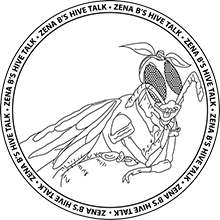Hive Talk - February 2020
February 2020 "Mitey Talk"

Zena B’s Hive Talk - February 2020
February is a month where a beekeeper is patiently waiting for spring to come. Placing orders for equipment, pollen supplements, treatments for varroa mites, and waiting for sales on sugar.
Varroa mites you ask? These little critters are a bee’s nemesis! Every hive has them, it is up to the beekeeper to control them otherwise these little ‘suckers’ will take the life of your hive.
It all starts with one mite being brought in by a rogue honey bee, or existing mites within the hive.
The Varroa mite will attach themselves onto the bee. They cling to the bees like ticks on a deer. They are very, very, small. When the female mite is ready to lay eggs, she rides the worker bee around brood frames until she sees a nice warm nest, like a drone cell, to lay her eggs. She will then drop off her ride and crawl into a brood cell to lay her eggs along side a nice healthy, plump and juicy, larvae. Unknown to the worker bees, they will cap the cell after filling it with food for the larvae. As the young bee develops the varroa mite eggs will hatch and the little baby mites will latch onto the juicy baby bee and slowly suck the life out of it. It doesn’t necessarily kill the bee, but will weaken it just enough to survive and help the adult mites to populate, and lay their eggs again into the larvae cells, which will eventually weaken the whole hive and eventually kill the colony. Nasty!
But there is a line of prevention that the beekeeper is responsible for, if they want to maintain healthy colonies.
First of all a ‘mite test’ needs to be done to see if you need to do any preventive measures. I will take a cup of bees, drop them into a solution so that they are sacrificed for the good of the hive, I will give the container a good shake which loosens the Varroa mites which will be separated from the dead bees and drop to the bottom of the jar. I do a quick calculation to determine a ratio of mites vs number of bees in the jar. If there were 3 or less mites, we’re good. If there are more, I will apply the pesticide strips to rid the hive of its abundance of these pests.
There is a time period that the pesticide is in the hives, then a waiting period of two weeks after removing the pesticide, then after that the bees are good to go, I will put the honey supers on, and a healthy season proceeds.
There are other diseases that affect the hives, some are very contagious to other colonies. Even if the other colonies are many, many miles away, or being transported past your area, on a flatbed truck. American Foulbrood is the most devastating. That is why it is so important to register your hives with the Province so that you are aware of nearby Apiaries so that you can keep in touch with one another to prevent any contamination. A very important ‘good neighbour’ policy.
That’s one of the many pests that beekeepers deal with.
We are currently sold out of our delicious raw honey. However, if you go onto my website you can hold an order until spring. It will be a client list that I will serve first. Zenabshoney.com
Until next month, Bee Kind! Take Care.
ZenaB’s Raw Honey zenabshoney.com 1-306-679-2207
Picture of Varroa Mite and Bee is from 'sciencemag.com'
